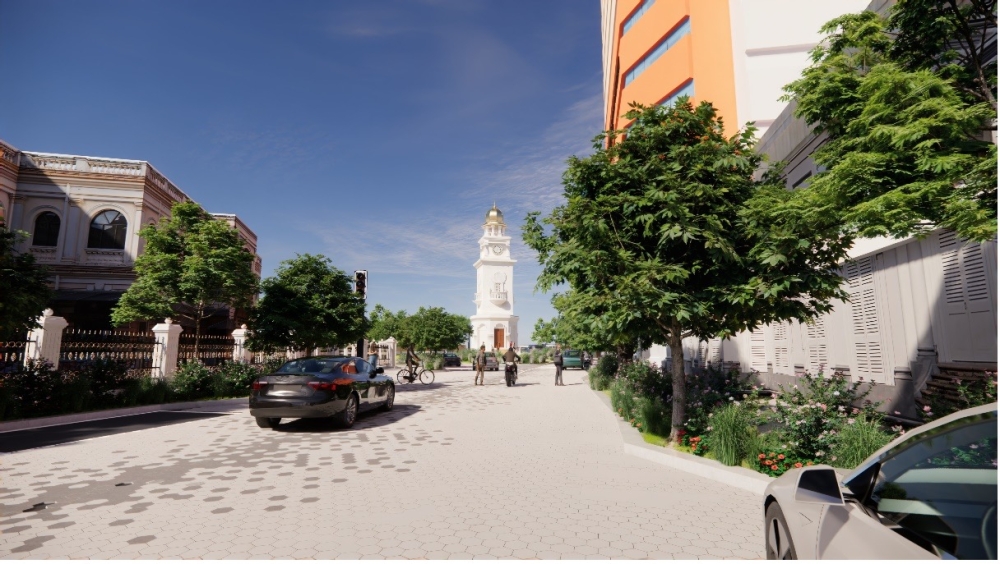GEORGE TOWN, July 20 — In George Town’s historic core, one of Penang’s oldest roads is about to get a major facelift, not just for heritage, but for the climate.
Beach Street, once a waterfront artery for commerce and now a bustling financial centre, has been selected as the starting point for Penang’s ambitious plan to cool down its inner city and return its streets to people, not just cars.
The Penang Island City Council (MBPP) is launching a RM24.7 million pilot project that will transform a 1.76km loop around Beach Street into a climate-responsive, pedestrian-friendly zone.
MBPP Mayor Datuk A. Rajendran said the aim is to reclaim public space and combat the heat island effect caused by concrete, tarmac, and the dense rows of old shophouses.
“We want to bring down urban temperatures by planting more trees and at the same time, increase the walkway width while reducing the carriageway,” he told Malay Mail in a recent interview.
The project is partly funded by a World Bank Adaptation Fund grant under the Nature-Based Climate Adaptation Programme for Urban Areas of Penang Island (PNBCAP), with MBPP covering the other half.
“This can be replicated in other streets in the city and it can be a model for other cities to replicate to bring down urban heat and improve walkability,” Rajendran said.
He said stakeholder engagement sessions have so far been positive and the council has already awarded the contract, with work slated to begin on September 1 and complete by February 2027.
The planned works will go beyond cosmetic upgrades.
What to expect
Footpaths will be widened, more trees planted, and new pocket parks added to encourage walking while reducing temperatures.
The Queen Victoria Memorial Clock Tower, now surrounded by a traffic roundabout, will be transformed into a focal point for a pedestrian pocket park with safe street crossings.
To make space for the changes, Beach Street and Church Street Ghaut will be converted into one-way streets, while the number of roadside parking spaces in the loop will be reduced from 293 to just 100.
The project will also introduce clean energy solutions.
These include solar panels to power street lights and phone charging stations, and a kinetic walkway that captures energy from footsteps to power low-energy infrastructure.
Soil cell systems – underground structures that help trees grow healthy roots without damaging pavements – will be used to support the new trees.
But for all its future-looking ambitions, this project is deeply rooted in George Town’s past.
Here is a closer look at the streets involved.
Roads affected
Beach Street, laid out in 1786 along with Light Street and Chulia Street, was among the first roads drawn up after Francis Light arrived in Penang.
Originally hugging the eastern shoreline, it lost its coastal view after major land reclamations in the late 19th century pushed the sea further east.
Today, it remains one of the busiest streets in George Town, lined with banks, offices, and heritage shophouses.
But the upgrade will reach beyond Beach Street to the adjacent roads – each with their own layered stories.
Weld Quay, for instance, was born of the same 19th-century land reclamation that distanced Beach Street from the sea.
Named after Sir Frederick Weld, a former Governor of the Straits Settlements, the road once connected George Town to its thriving port and continues to serve as a vital link to Swettenham Pier, the Raja Tun Uda Ferry Terminal and RapidPenang’s bus terminal.
Chulia Street Ghaut, once a simple sandy track to the shoreline, emerged from that same wave of reclamation as an extension of Chulia Street, directly linking to Weld Quay.
It now traces the old footprint of Yeoh Kongsi, a clan house once open to the waterfront.
Pesara King Edward (also known as King Edward’s Place), a short but significant stretch, connects Light Street to Weld Quay and was created during land reclamation between 1880 and 1904.
It is home to early 20th-century godowns and post-war office buildings, and leads directly to Swettenham Pier and Penang Port Sdn Bhd’s headquarters.
Downing Street, inspired by its London namesake, was once the seat of British administration in Penang after land reclamation in the early 1880s.
Though many of its colonial buildings were lost during World War II, the road remains a key part of the city’s administrative memory, now occupied by a large parking lot.
Church Street Ghaut was added as a reclamation-era extension of Church Street, historically lined with warehouses that supported George Town’s maritime trade.
Today, those old godowns are being revitalised as trendy cafés, art galleries and boutique lodgings.
China Street Ghaut, once a boundary road for the Chinese tradesmen community, shares a similar story – created during the late 19th-century reclamation and now part of the city’s heritage grid.
Victoria Street, once mudflats along the coast, was built between 1880 and 1904 and earned the local Hokkien name hai kee sin lor, meaning “new road by the sea.”
Only a short 200-metre section of this nearly 1km-long road will be included in the redevelopment, but its transformation is no less symbolic.
Across the entire loop, the MBPP aims to not only reduce surface temperatures but also bring back vibrancy through greener, safer streets.
With climate change looming and urban temperatures rising, Penang hopes the new Beach Street can be both a nod to the past – and a blueprint for the future.

